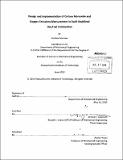| dc.contributor.advisor | Ahmed F. Ghoniem. | en_US |
| dc.contributor.author | Sommer, Andrew (Andrew Zhang) | en_US |
| dc.contributor.other | Massachusetts Institute of Technology. Department of Mechanical Engineering. | en_US |
| dc.date.accessioned | 2014-01-09T19:50:35Z | |
| dc.date.available | 2014-01-09T19:50:35Z | |
| dc.date.issued | 2013 | en_US |
| dc.identifier.uri | http://hdl.handle.net/1721.1/83745 | |
| dc.description | Thesis (S.B.)--Massachusetts Institute of Technology, Dept. of Mechanical Engineering, 2013. | en_US |
| dc.description | Cataloged from PDF version of thesis. | en_US |
| dc.description | Includes bibliographical references (page 33). | en_US |
| dc.description.abstract | Oxy-fuel combustion in natural gas power generation is a technology of growing interest as it provides the most efficient means of carbon capture. Since all the emissions from these power plants are sequestered, there are stringent regulations on the proportions of oxidizable contents in the flue gases. This work investigates natural gas oxy-fuel combustion and represents the first iteration of carbon monoxide and oxygen emissions measurement in hot flue gases in the swirl-stabilized combustor at the MIT Reactive Gas Dynamics Laboratory. An equilibrium model using CANTERA was provided estimates for the experimental observations and was used to determine the accuracy of the measurement system. A water-quenched probe was designed and built to cool the sample gas and to allow measurements using a commercially available Lancom gas analyzer. Modifications to the existing combustion setup were made to facilitate emissions measurement at a sampling duct located downstream of the combustion chamber. Measurements for comparison between air and oxy fuel combustion were done at a constant adiabatic flame temperature. This corresponds to an equivalence ratio of 0.6 for air, and a CO₂ mole fraction of 0.69 for oxy-fuel combustion. Overall the measurement system provided reasonable readings for air-combustion, but measurements in oxy-fuel combustion understated the expected CO concentrations by a factor of four and overstated expected O₂ values by an order of magnitude. Air leakage into the combustion chamber is the suspected reason for these discrepancies, and recommendations are laid out for the next iteration of emissions measurement. | en_US |
| dc.description.statementofresponsibility | by Andrew Sommer. | en_US |
| dc.format.extent | 36 pages | en_US |
| dc.language.iso | eng | en_US |
| dc.publisher | Massachusetts Institute of Technology | en_US |
| dc.rights | M.I.T. theses are protected by
copyright. They may be viewed from this source for any purpose, but
reproduction or distribution in any format is prohibited without written
permission. See provided URL for inquiries about permission. | en_US |
| dc.rights.uri | http://dspace.mit.edu/handle/1721.1/7582 | en_US |
| dc.subject | Mechanical Engineering. | en_US |
| dc.title | Design and implementation of Carbon Monoxide and Oxygen emissions measurement in swirl-stabilized oxy-fuel combustion | en_US |
| dc.title.alternative | Design and implementation of CO and O₂ emissions measurement in swirl-stabilized oxy-fuel combustion | en_US |
| dc.type | Thesis | en_US |
| dc.description.degree | S.B. | en_US |
| dc.contributor.department | Massachusetts Institute of Technology. Department of Mechanical Engineering | |
| dc.identifier.oclc | 864716181 | en_US |
